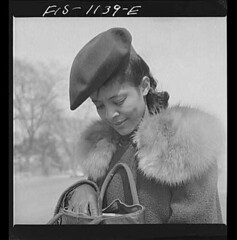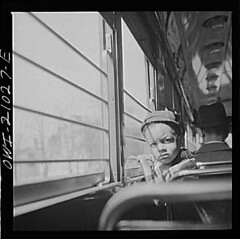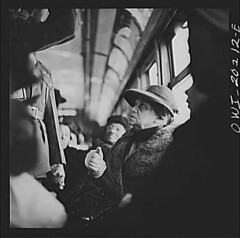When seeing isn't believing, how do you correct for vision impairment?
 Jewal Mazique, worker at the Library of Congress, waiting for a streetcar on her way home from work. FSA Photo, Winter 1942, John Collier. Source: Library of Congress.
Jewal Mazique, worker at the Library of Congress, waiting for a streetcar on her way home from work. FSA Photo, Winter 1942, John Collier. Source: Library of Congress.The City Paper reports, in "Exile on Main Street," on the recent trip to Portland, Oregon, for Anacostia-area residents, Councilmembers Vincent Gray (Ward 7) and Marion Barry (Ward 8), and DC DDOT Director Dan Tangherlini, and that the residents who went on the trip came back as opponents of the new plan to put the streetcar system on the street, rather than on a dedicated separated line. I guess this contradicts my blog entry "When people don't have experiences, site visits are the way to go." It's too bad that the people who went to Portland from DC didn't likely talk to the person mentioned in this part of that blog entry:
 Boy on a Washington Streetcar. FSA Photo, 1943, Esther Busby. Source: Library of Congress.
Boy on a Washington Streetcar. FSA Photo, 1943, Esther Busby. Source: Library of Congress.One of the tours I went on in Portland was of the new Yellow Line Light-Rail line, which is located in a more "emerging" area of the city, one that has experienced economic distress, closure of manufacturing, and is also more ethnically and racially diverse.
One of the presenters was a citizen, who originally opposed the light rail because of how it was to be funded -- because the original line was to go from Vancouver, Washington to Oregon City, a city east of Portland (you can't really call it a suburb, as its development really came out of the time it took to travel in one day, back when getting around took a lot longer, i.e., in the mid-1800s), it required a bond approval vote of the entire state. Such a referendum failed twice. So the city of Portland through the Portland Development Commission created an "Urban Renewal District" which allowed for the sale of bonds against future tax revenue increases.
To make a long story short, once this person saw the impact of the new line in terms of greater connectivity and the slow but steady improvements in commercial districts along the tracks, he understands much better why expanding transit makes sense, and today he is a strong supporter.
And the impact of the Light Rail on the Interstate/Yellow Line is nothing at this juncture, when compared to the impact of Light Rail and Streetcar in Portland's Center City.
 Ladies on the Washington Streetcar. FSA Photo, 1943, Esther Busby. Source: Library of Congress.
Ladies on the Washington Streetcar. FSA Photo, 1943, Esther Busby. Source: Library of Congress.While I recognize that DC neighborhoods have suffered for decades from disinvestment, I have come to believe that not all the ills of our neighborhoods can be blamed on abandonment, but can also be attributed to lack of vision, failure to step up and mark hard choices, and a variety of other reasons.
Earlier in the week I wrote with incredulity about the Monday Post article about H Street, in a blog entry I entitled "It helps to have good PR agents." This article seemed to drink in the kool aid that says that urban renewal is a good thing. The neighborhood blog Frozen Tropics also weighed in on the article.
Afterwards I decided to mine the Post archives and I went through 7 years of Washington Post articles (1979-1986) just using the keyword "Hechinger Mall." I intend to write a much longer analysis of what I found--but flu got in the way of my best intentions at least thus far.
In any case, the same kinds of articles about the "revitalization of a neighborhood being right around the corner" kept getting written like clockwork, every couple years. Meanwhile, you could read the drumbeat of unvital signs--the Safeway on H Street closing (because of the Safeway opening at Hechinger Mall), the Post Office on H Street closing (because Hechinger Mall drew away the once even post-riot pedestrian traffic), how the opening of Hechinger Mall didn't lead to a revitalization of the residential neighborhoods around the mall, etc.; picketing of Hechinger Mall construction due to the underutilization af African-American contractors; that Rosalynn Carter made her way on H Street at one point, to herald a new day for this riot-scarred corridor, etc....
Fascinating reading. I guess a key value of the Post is in the accumulation of articles over time.
Anyway, I can't believe that residents with open minds couldn't go to Portland, look at how both the Light Rail (MAX) system and the Portland Streetcar system are integrated into the city, much like streetcars used to be, making transit easily accessible and usable rather than requiring a separate trip-hike to a subway station, and be convinced of the utility here.
On the other hand, looking at that cumulation of Post articles, or the articles listed in the blog entry from earlier in the week, you see that DC residents and business owners have a long history of being disappointed.
Still you can't have progress without a willingness to open your eyes. And if your vision's faulty, the acquisition of vision aids (rather than kool aid).



0 Comments:
Post a Comment
<< Home